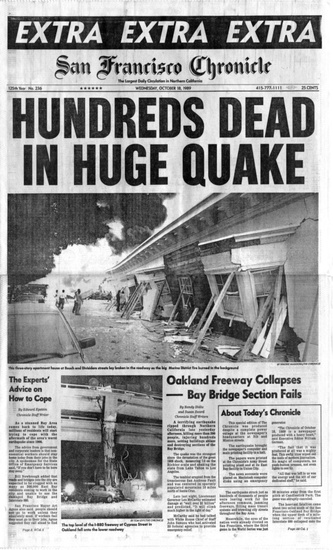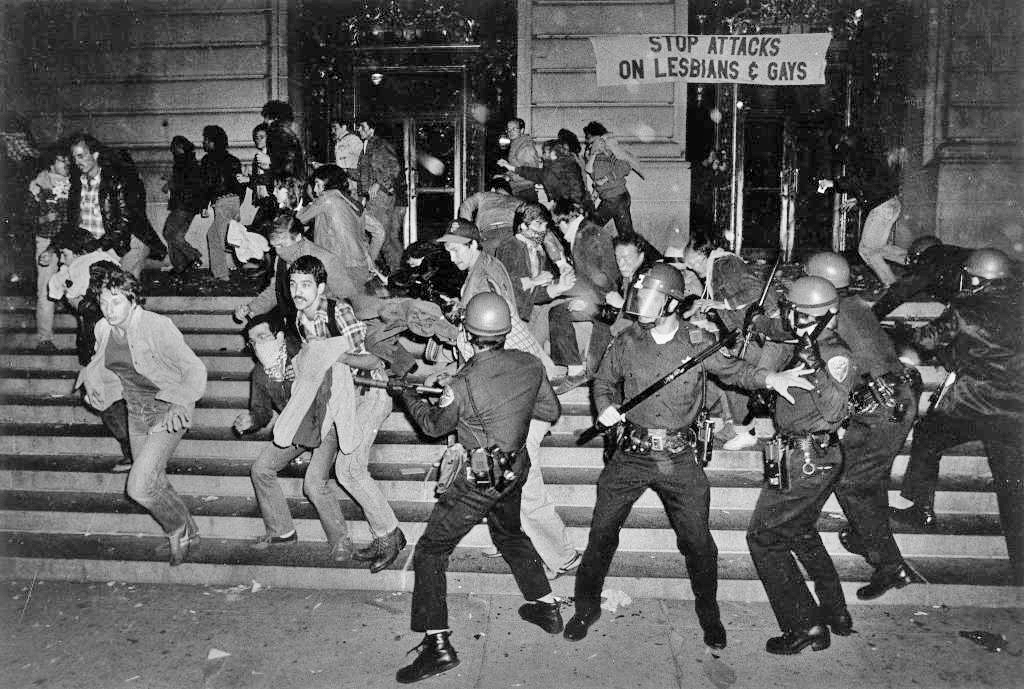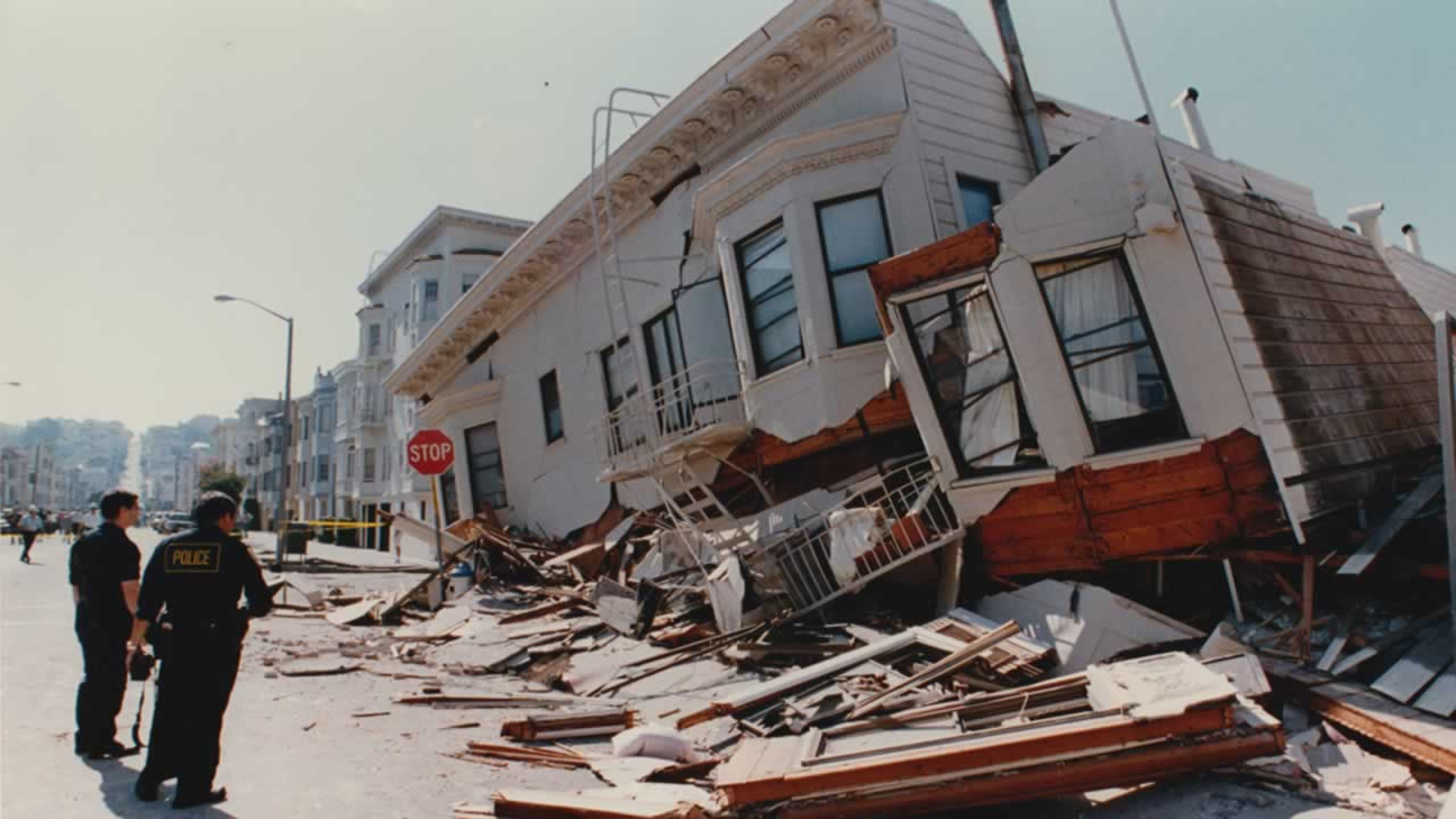My wife Beverly and I had great seats for Game Three of the 1989 World Series between the San Francisco Giants and the Oakland A’s. Our seats were down the third baseline, about half way between the base and the outfield fence. We were about ten rows back from the field. It was a game of great apprehension – the Giants had already lost the first two games of the series in Oakland and were determined to get back in the win column now that the Series had shifted to Candlestick Park. Although I was a die-hard Giants fan, I have to admit that I was looking forward to watching A’s star players Mark McGwire, Dave Stewart and Jose Canseco.
As we settled into our seats, the crowd was excited and noisy. Players were on the field tossing the ball around and getting warmed up. Pre-game announcements blared from the loudspeakers. Then, at exactly 5:04 PM, we both felt a noticeable jolt and when we looked at the upper deck, we could see portions of the stadium sway.
Earthquake! Not an uncommon occurrence in San Francisco and after a split second when people realized that the stadium was not going to collapse, there was a cheer from the crowd, as if to say “Welcome to San Francisco. This is part of who we are!” The crowd buzz resumed, even as players were hustled off the field.
Two rows behind us, a small group was huddled around a small portable television and we heard someone say, “The bridge collapsed.” I stepped over the seats to get a look at the television and saw a gaping hole in the Bay Bridge. I immediately said to Beverly, “We’ve got to get out of here now!” People were only starting to exit the stadium and we were ahead of the crowd. We did not have a cell phone, so we couldn’t check on our three-year-old daughter who had gone on a play date with a neighbor and her children.
I tried the Sheriff’s Department radio in the car, but got no reception, so we zoomed back to our home in Bernal Heights and made some quick calls. Our daughter was fine. She and her pal had been running across the field in Glenn Park and she unexpectedly lost her balance and fell down. She wasn’t hurt, but couldn’t figure out how she had lost her balance.
I rushed to my City Hall office to retrieve a department hand held radio. There was plaster and debris all over the City Hall rotunda and a few people assessing damage. When I got to my 3rd floor office, I couldn’t open the door because a file cabinet had fallen across the doorway. After some pushing, I got into the office and saw files and paperwork on the floor, some furniture overturned, but no serious damage. I grabbed a radio and set off to figure out the conditions in the jails and to get Sheriff’s staff together to respond to whatever was needed.
The next ten days were a blur of 20-hour days, daily meetings with the Mayor and other department heads, creating jobs that were new to the Department and pitching in wherever possible.
For the Sheriff’s Department, the 1989 Earthquake became a significant turning point, expanding the duties and visibility of the Department like never before.
The San Francisco Sheriff’s Department and the San Francisco Police Department have always had a professional competitiveness. The PD is the big dog, with around 2,000 officers. The SFSD is the other dog, with just under 1,000 officers. The cops are the glamour agency with televised arrests and gigantic funerals. The sheriff deputies labor largely out of sight inside the jails and the City’s various court rooms.
For the most part, the two agencies historically kept their distance and interacted very little. For example, on May 21, 1979 there was a full-blown riot at San Francisco City Hall in the aftermath of the jury verdict in the Dan White murder trial. White was convicted of voluntary manslaughter, which was viewed as a slap on the wrist for his brutal murders of Mayor George Moscone and Supervisor Harvey Milk.
That evening, City Hall was overwhelmed by a growing and angry crowd. Projectiles were thrown, the doors to City Hall were bashed in, and, most dramatically, a line of parked Police cars were set on fire.
The San Francisco Police Department responded to the chaos and, seeing the massive angry crowd, called for mutual aid – from the Alameda County Sheriff’s Office. No thought was given to seeking assistance from the City’s other law enforcement agency—the San Francisco Sheriff’s Department.
Not long after this event, the Sheriff’s Department started an Emergency Services Unit (ESU) to train a cadre of deputies for critical incidents, crowd control, high security transport, and general mutual aid.
Prior to 1980, it was rare that the SFPD ever sought assistance from SFSD. There had been some interagency training and joint operations during Vietnam War demonstrations, and in 1977 both agencies worked together, although with separate responsibilities, during the controversial evictions at the International Hotel. But, apart from being prepared to accept large groups of arrestees during demonstrations, very little was expected of SFSD by SFPD.
Beginning in 1980, the Department began the development of the Emergency Services Unit (ESU) as a new component to the Department. The head of our Training Unit, Lt. Terry White, attended ESU development training with the New York Police Department and brought the concept back to our Department. We developed criteria for eligible staff, began procuring safety equipment and started a detailed training curriculum. Collective bargaining secured differential pay for deputies volunteering to join the Emergency Services Unit.
The ESU was called upon for high security transports, field bookings at mass arrest locations, added security at large events such as the Democratic National Convention in 1984 and the visit of Pope Paul II in 1987. These events required joint planning and training with the SFPD leading to greater agency familiarity and comfort. Eventually the City established an Emergency Operations Center (in 2000) which essentially forced all City agencies to work and plan together in response to disasters, critical incidents or other emergencies.
The working relationship between the two San Francisco law enforcement agencies was slow getting off the ground. Gradually, deputies would be sought to assist with mass bookings at demonstration sites and to prepare plans for other interagency events. Some newly hired deputy sheriffs were trained at the SF Police Academy (and some were even recruited to join the PD right out of the Academy).
But the event that made the most dramatic change was the 1989 Earthquake. The damage throughout the City was extensive. The loss of electrical power in many neighborhoods left the streets and houses dark at nightfall. Many people were not allowed back in their homes or apartments because of structural damage, leading to an enormous homeless population.
The Earthquake hit at 5:04 pm. The Sheriff’s Department immediately put out a call for all available officers to respond to either the Hall of Justice or the San Bruno jail. Fortunately, the jail facilities suffered little in the way of structural damage. Even though all of the jails were without power for the first 24 hours, emergency generators provided the minimum power necessary for the jails to function.
By 10:00 pm the Department had its first request for mutual aid. Eighty deputies were immediately assigned to street patrol with police officers at Potrero, Southern, and Northern stations.
An emergency housing area for people who had lost their homes was set up in Moscone Convention Center with police personnel providing security. After a brief trial run, the PD asked that deputies take over those duties, sensing that deputies were better trained to manage crowded housing conditions.
Mayor Art Agnos held daily outdoor department head meetings at a baseball diamond a couple of blocks west of City Hall. Department personnel sat in the bleachers while Mayor Agnos, standing on the third baseline, organized the City’s response.
For the next 72 hours, over 200 deputy sheriffs performed all sorts of mutual aid duties throughout San Francisco. They patrolled the Marina neighborhood; they rode shotgun with the Red Cross and the Fire Department; they secured barricades at areas that were off limits due to unsafe structures or damaged roadways. Twelve-hour shifts were the norm and sleeping areas were set up in the 7th floor prisoner recreation hall at the Hall of Justice and at the San Bruno jails.
All of this was accomplished despite the Sheriff’s Department being woefully under-provisioned for such a massive emergency. For example, the Department did not have sufficient protective ballistic vests for deputies going on street patrol, so we borrowed 50 vests from the Police Department. A similar shortage hampered communications. The Department had only 140 hand-held radios and those included radios from four different manufacturers, meaning batteries were not interchangeable. Many of the radios had to remain in the jails for officer safety in the facilities. On top of that, none of our radios were on the same frequency as the Police. These handicaps were largely overcome by partnering deputies with police officers. Ultimately, however, this experience led to the creation of a unified public safety radio/communications system for police, sheriff and fire.
Except for a brief period immediately after the quake, bookings of arrestees continued without interruption and just three days after the quake the criminal courts were again functioning with bailiffs and other Hall of Justice security. The overall experience demonstrated that the Department was severely under resourced with regard to safety equipment, but well-trained and ready to perform emergency law enforcement duties when called upon.
San Francisco recovered from the 1989 Earthquake, and for the first time its traditionally stand-alone law enforcement agencies truly became more of a community. After the Quake, it became the norm for sheriff’s deputies to be on the street with the police at major demonstrations, at events like New Year’s Eve and Halloween, and when a massive security presence is necessary such as the visit of Pope John Paul II or the Major League Baseball All-Star Game.
Ironically, not so many years after the City Hall White Night Riot, when riots were taking place in Oakland it was the San Francisco Sheriff’s Department who received and responded to mutual aid requests from the Alameda County Sheriff’s Office. We had come full circle.




